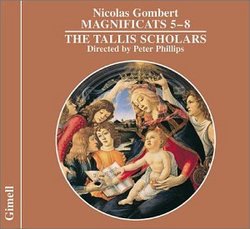| All Artists: Nicolas Gombert, Tallis Scholars, Peter Phillips Title: Magnificats 5-8 Members Wishing: 0 Total Copies: 0 Label: Gimell UK Release Date: 9/10/2002 Album Type: Import Genre: Classical Styles: Opera & Classical Vocal, Historical Periods, Early Music Number of Discs: 1 SwapaCD Credits: 1 UPC: 755138103825 |
Search - Nicolas Gombert, Tallis Scholars, Peter Phillips :: Magnificats 5-8
CD Details |
CD ReviewsComplex and graceful, too FrKurt Messick | Bloomington, IN USA | 08/05/2005 (5 out of 5 stars) "--Nicholas Gombert--
Like many of his generation, details of his life are somewhat hard to come by - it is believed Gombert was born in 1490 in southern Flanders. He probably studied with the great composer Josquin during his retirement in the years leading up to 1520. Employed by emperor Charles V as a singer in his court chapel in 1526, he later became master of the boys for the royal chapel. He traveled with the emperor, and eventually was appointed chorus master at Tournai, and probably he spent much of his life there after 1534. Records indicate Gombert was convicted of molesting a boy and sentenced to hard labor; later pardoned, he returned to Tournai by the 1550s (when his Magnificat settings were published). By 1561, he was dead, but it is not certain exactly when that happened, either. --Magnificats 5-8-- It is said that Gombert wrote the eight Magnificat settings (four of which are on this disc, and four of which are on a companion disc) as an offering to the emperor to gain his favour; Charles V was apparently so moved by them, he granted Gombert's release. Gombert was highly influenced by Josquin, but is rather more fond of dissonance than he. Gombert is a strong link in the chain of composers between Josquin and the later, great Palestrina. Strong polyphony is present in the Magnificat, traditional pieces of liturgy derived from the Song of Mary, the prayer of the Blessed Virgin Mary after the Annunciation. There is variety as the verses in the Magnificats vary - even verses in polyphonic, odd verses in chant. There is also a momentary clash or dissonance at the end of a cadence, intentionally, and that can be heard in this recording. All of these pieces are glorious complex polyphonic compositions of extraordinary power and grace. Taken as a set, they make a wonderful snapshot of Roman Catholic sensibility of the time, and greatly representative of the state of liturgical/religious music of the time. This CD includes antiphonal pieces between the Magnificat settings. These give the tones upon which each Magnificat is based. --The Tallis Scholars- The Tallis Scholars are a group dedicated to the performance and preservation of the best of this type of music. A choral group of exceptional ability, I have been privileged to see them many times in public, and at almost every performance, their work is stunning and delivered with near-flawless grace. Directed by Peter Phillips, the group consists of a small number of male and female singers who have trained themselves well to their task. This recording deserves more than five stars; it deserves a place on the shelf of anyone who loves choral music, liturgical music or Gregorian chant, classical music generally, or religious music. This particular recording was made during 2002 in the Church of Saint Peter and Saint Paul, Salle, Norfolk, one the Tallis Scholars' regular recording sites. When listening, fair warning: prepare to be moved. " |

